Battle of La Rothière
| Battle of La Rothière | |||||||
|---|---|---|---|---|---|---|---|
| Part of the War of the Sixth Coalition | |||||||
 Württemberg dragoons charging French infantry | |||||||
| |||||||
| Belligerents | |||||||
|
|
| ||||||
| Commanders and leaders | |||||||
|
|
| ||||||
| Strength | |||||||
|
45,000 128 guns | 80,000 | ||||||
| Casualties and losses | |||||||
|
5,600 dead, wounded or captured 73 guns | 8,000–9,000 dead or wounded | ||||||
The Battle of La Rothière was fought on 1 February 1814 between the French Empire and allied army of Austria, Prussia, Russia, and German States previously allies with France. The French were led by Emperor Napoleon and the coalition army was under the command of Gebhard Leberecht von Blücher. Attacked by a large force in severe weather conditions (wet snowstorm), the French managed to hold until they could retreat under cover of darkness. Multinational coalition forces used white shoulder bands to distinguish friends from foes during the battle.
Battle

The French army counted about 45,000 men in 57 battalions and 62 squadrons, supported by 128 artillery pieces. The Imperial Guard was commanded by General of Division Philibert Jean-Baptiste Curial. Marshal Claude Perrin Victor led the II Corps with three infantry divisions under Generals of Division François Antoine Teste, Jean Corbineau, and Georges Mouton. General of Division Emmanuel Grouchy led the cavalry. On the Allied side, Prince Scherbatov led the Russian 6th Corps, General-Leutnant Zakhar Dmitrievich Olsufiev directed the Russian 9th Corps, Count Liewen III commanded the Russian 11th Corps, Feldzeugmeister Ignaz Gyulai led the Austrian 3rd Corps, Crown Prince Frederick William of Württemberg directed the 4th Corps, General der Kavallerie Karl Philipp von Wrede commanded the Austro-Bavarian 5th Corps, and there were several independent cavalry divisions.[1]
Results
Historian Digby Smith stated that French losses numbered 4,600 killed and wounded. The Allies captured an additional 1,000 soldiers and 73 guns. The large loss of artillery was partly due to Allied cavalry superiority and partly due to the soggy condition of the ground, which made it difficult to withdraw the pieces. The Allies lost between 6,000 and 7,000 casualties.[2]
Notes
- ↑ Smith 1998, p. 491-492.
- ↑ Smith 1998, p. 492.
References
- Chandler, David G. (1966). The Campaigns of Napoleon. New York, NY: Macmillan.
- Chandler, David G. (1999). Dictionary of the Napoleonic Wars. New York, N.Y.: Wordsworth.
- Nafziger, George (1994). "Allied Forces, Battle of La Rothière, 1 February 1814" (PDF). United States Army Combined Arms Center. Retrieved 20 February 2016.
- Nafziger, George (1994). "French Forces, Battle of La Rothière, 1 February 1814" (PDF). United States Army Combined Arms Center. Retrieved 20 February 2016.
- Petre, F. Loraine (1994) [1914]. Napoleon at Bay: 1814. London: Lionel Leventhal Ltd. ISBN 1-85367-163-0.
- Smith, Digby (1998). The Napoleonic Wars Data Book. London: Greenhill. ISBN 1-85367-276-9.
External links
Coordinates: 48°20′45″N 4°33′30″E / 48.3458°N 4.5583°E